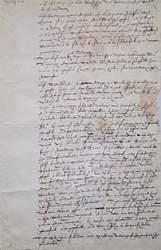Newfoundland's Oldest Document Describes Life in Cupids
From the files of The Gazette November 04, 1993.
The oldest Newfoundland document in the archives is the John Guy News-Sheet. In England, in the days before newspapers were common, the news was often handwritten on sheets of paper and pinned to the wall or door of some public building where the passers-by could read it. One such news report dated 29 January 1611 told of the appointment of an archbishop to the privy council, a visit to London by the teenage son of the Langrave of Hessens, the tragedy surrounding the selection of a new mayor at Norwich, the health of Lord La Ware and a decision to colonize Bermuda. Over one-third of the news-sheet is occupied by a report of "Mr. Guye of Bristow" and the colony he had established in the new world the previous year. "Mr. Guye of Bristow" was John Guy and the colony was in Newfoundland at the site of present-day Cupids, Conception Bay.

Courtesy of Archives and Special Collections, Queen Elizabeth II Library, Memorial University of Newfoundland, St. John's, NL.
The news of Guy's colony was good news: he had built a "convenyent house", increased the numbers of livestock ("Ducks, Geese, Henns, Conneyes, Goats, Swyne and Kyne") he had taken with him, found plenty of wild animals that had been killed for food or skins, and he and his band of colonists "have Healthfully endured the sharpest could [cold]". He planned to return to England at the next Michaelmas and gather persons to establish a second colony; he was sure that all those who partook in this venture would find it "very lykelye to be profitable." Guy's initial enthusiasm did not last, however; by 1615 he was no longer involved with its operation and sometime in the 1620s the colony is believed to have been abandoned.
How did this news-sheet from London dated 1611 end up at Memorial University? That story dates back to 1933 when Nimshi Crewe, a St. John's-based public accountant and avid collector of Newfoundlandiana, learned that the item was being offered for sale by the London bookseller Francis Edwards Ltd for £20. In 1933 the British pound had a value of $4.50+ in Newfoundland currency. In order to purchase the document, Crewe established a public campaign to raise the necessary funds with the intention of presenting it to Memorial University College. Within days he had raised the money; the subscription list read like a who's who of St. John's educators, lawyers and businessmen, including Vincent Burke, R. K. Kennedy, I. J. Samson, Dr. William Blackall, Campbell MacPherson, J. G. Higgins, Leslie R. Curtis, Gerald S. Doyle, Calvert Pratt and Peter O'Mara. The funds, which eventually totalled $96.00, were deposited in a special account in the Canadian Imperial Bank of Commerce. From that account, on May 5, Crewe arranged for a money order for £20 ($90.92 + .18 for the stamp = $91.10) to be drawn in favour of Francis Edwards Ltd. (The remaining $4.90 was refunded to the last three subscribers.) On May 22, 1933 the news-sheet, with a specially-bound, red-leather case, was officially presented by Crewe to the Trustees of Memorial University College as a gift to the College Library.
The news-sheet is contained on a piece of paper measuring 31 x 20.5 cm. The paper has yellowed slightly and there is foxing (brown stains) in spots but the writing is still quite clear and legible. The case in which it is kept also contains a printed transcript of the news-letter. The accompanying documentation includes the original list of subscribers and the amounts each donated, the receipt book, the bank book for the fund, the receipt for the money order to Frances Edwards Ltd., the withdrawal slip for $4.90 (to refund the excess money), an invoice from Edwards and correspondence between Crewe and the Board of Trustees. The collection is just one of the many Newfoundland treasures to be found in Archives and Special Collections.




